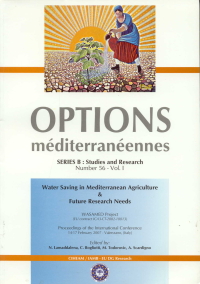| Article précédent | p. 223-233 | Article suivant |
Legume production and irrigation strategies in the Aral sea basin: yield, yield components and water relations of common bean (Phaseolus Vulgaris) and green gram (Vigna Radiata (L.) Wilczek)
In the Aral Sea basin, limited water resources, environmental damage and extensive production of cotton have lead to a need for more efficient irrigation strategies and the production of crops that could aid in food self sufficiency. Improved irrigation methods are needed, to increase the productivity of agricultural land and improve food supply. The objective of this work was to examine the effect of irrigation strategies on the yield and yield components of two legume species, produced after the harvest of winter wheat. Water relations were also examined. The research was conducted during two successive growing seasons in the Fergana Valley of Uzbekistan. The experiment was organized following a randomized complete block split-plot design with four blocks. The treatments were comprised of factorial combinations of three factors: regulated deficit irrigation level (recommended level, moderate deficit and severe deficit), irrigation water distribution pattern (alternate and every furrow irrigation) and crop [bean (Phaseolus vulgaris) and green gram (Vigna radiata (L.) Wilczek)]. Regulated deficit irrigation decreased yields of common bean, but increased yields of green gram. Alternate furrow irrigation did not reduce yields and, in general, green gram yields were higher than those of common bean. The combination of alternate furrow and deficit irrigation can allow legume production with reduced water inputs. A winter wheat-legume rotation appears feasible in Uzbekistan and provides a more food self-sufficient alternative that can be integrated the current cotton-winter wheat cropping system.
Dans le bassin de la mer d'Aral, des stratégies d'irrigation plus efficaces et une production agricole contribuant à l'autosuffisance alimentaire apparaissent nécessaires étant donnés les ressources limitées en eau, les dommages causés à l'environnement et la production extensive de coton. L'objectif de cette étude est d'examiner les relations hydriques et les effets des stratégies d'irrigation sur les composantes de rendement de deux cultures de légumineuses, produites après la récolte de blé d'hiver. Cette recherche a été menée pendant deux saisons de croissance successives dans la vallée de Fergana, en Ouzbékistan. L'expérience comportait quatre blocs, organisés en blocs aléatoires complets et en parcelles divisées. Les traitements comprenaient les combinaisons factorielles de trois facteurs : le niveau d'irrigation déficitaire (recommandé, stress modéré ou stress sévère), la distribution (irrigation alternée ou conventionnelle) et la culture [haricot commun (Phaseolus vulgaris) ou haricot mung (Vigna radiata (L.) Wilczek)]. L'irrigation déficitaire a diminué les rendements du haricot commun mais a augmenté ceux du haricot mung. L'irrigation alternée n'a pas diminué les rendements et en général, ceux du haricot mung étaient supérieurs à ceux du haricot commun. La combinaison de l'irrigation déficitaire et alternée permet la production de légumineuses tout en réduisant la consommation d'eau. Une rotation de culture blé d'hiver et légumineuses semble possible en Ouzbékistan. Elle apporterait une alternative pour l'autosuffisance alimentaire et pourrait être intégrée à la rotation actuelle coton-blé.
- [ Afficher ]
- [ Télécharger ]
- [ Exporter la citation ]
Vous pouvez télécharger la citation au format :
- [ Imprimer ]
-
Mots-clés
COMPOSANTE DE RENDEMENT, DOSE D'IRRIGATION, IRRIGATION A LA RAIE, OUZBEKISTAN, PHASEOLUS VULGARIS, RELATION PLANTE EAU, RENDEMENT DES CULTURES, VIGNA RADIATACiter cet article
Bourgault M., Madramootoo C., Webber H., Horst M., Stulina G., Smith D.L. Legume production and irrigation strategies in the Aral sea basin: yield, yield components and water relations of common bean (Phaseolus Vulgaris) and green gram (Vigna Radiata (L.) Wilczek). In : Lamaddalena N. (ed.), Bogliotti C. (ed.), Todorovic M. (ed.), Scardigno A. (ed.). Water saving in Mediterranean agriculture and future research needs [Vol. 1]. Bari : CIHEAM, 2007. p. 223-233. (Options Méditerranéennes : Série B. Etudes et Recherches; n. 56 Vol.I). Proceedings of the International Conference WASAMED Project (EU contract ICA3-CT-2002-10013), 2007/02/14-17, Valenzano (Italy). http://om.ciheam.org/om/pdf/b56_1/00800115.pdf



